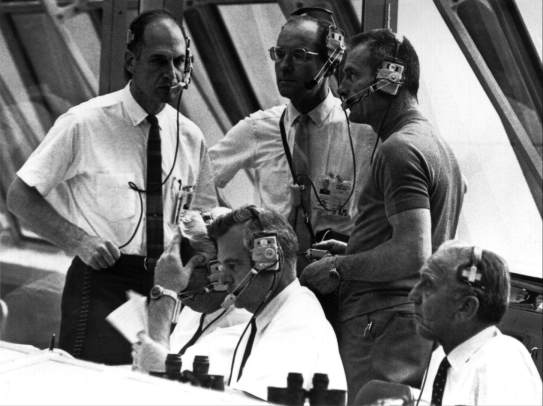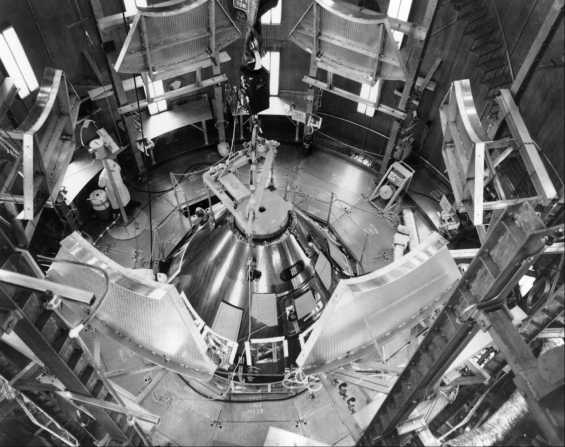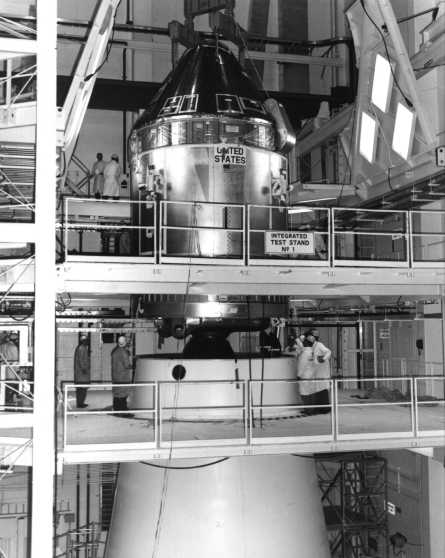
At Long Last

Apollo officials in the launch control center during the countdown for Apollo 10. From left, standing: George M. Low, Apollo Spacecraft Program Manager; Lt Gen. Sam Phillips, Apollo Program Director; and Donald Slayton, Flight Crew Operations Director, MSC. Seated, John Williams, Spacecraft Operations Directior; Walter Kapryan, Launch Operations Deputy Director; and Kurt Debus, KSC Director.
The liftoff of Apollo 10 on 18 May 1969 would mark KSC's fourth manned Apollo launch in the short space of seven months. The mobile concept was proving its efficiency. Before Apollo 8 moved out of the vehicle assembly building on 9 October 1968, the crews had already stacked AS-504 for Apollo 9. Before Apollo 9 was subsequently moved out, crews had stacked AS-505 for the Apollo 10 flight. Apollo 10 rolled out on 11 March to pad B, the more distant of the two pads on LC-39. This would prove the only use of pad B for an Apollo mission and the only use of firing room 3.
On the flight of Apollo 9, McDivitt, Scott, and Schweickart had checked out the lunar module in flight and docking maneuvers with the command-service module. On Apollo 10, the crew of Thomas Stafford, John Young, and Eugene Cernan took the spacecraft to the vicinity of the moon where the lunar module closed to within 16 kilometers of the surface before redocking with the orbiting command module. At long last, KSC was set for the Apollo 11 mission that would put men - Neil Armstrong and Edwin Aldrin, Jr. - on the moon while Michael Collins waited for them in the command module.

Testing the Apollo 11 spacecraft in the operations and checkout building. (1) The command and service modules in an altitude chamber. Segments of a workstand, used to work near the top of the spacecraft, have been lifted and pulled back against the circular walls of the chamber.

(2) Testing the landing gear of the lunar module.

(3) Mating the command and service modules with the spacecraft-lunar module adapter.
Apollo 11 stages had been arriving at KSC since the beginning of the year, the second stage undergoing rigorous inspection on account of a stormy barge voyage from California via the Panama Canal. During March the prime and backup crews participated in the spacecraft tests, with mid-April bringing the docking tests in the altitude chambers. During a checkout of the lunar module descent stage, technicians discovered faulty actuators in the machinery that would push out the legs of the lunar module for the moon landing. The repair area was inaccessible to men of average build, and Grumman scoured its rosters for two qualified technicians who were "very slim." The two men - William Dispenette and Charles Tanner - squirmed into the narrow space and replaced the actuators.36
The lunar module on Apollo 11 differed in several respects from that on Apollo 10. A very-high-frequency antenna would facilitate communications with the astronauts during their extravehicular activity on the moon's surface. The lunar module would also have a lighter-weight ascent engine, increased thermal protection on the landing gear, and a packet of scientific experiments. The only change in the command-service module was the removal of a blanket of insulation from the forward hatch. On the launch vehicle, the first stage was stripped of its research and development instrumentation. Insulation was improved on the second stage, and slight changes were made in the connections between the third stage and the instrument unit.37
The crawler-transporter picked up the 5,443-metric-ton assembly and started for pad A at 12:30 p.m. on 20 May while Apollo 10 was still on its way to the moon. The countdown demonstration test got underway 27 June with vehicle and spacecraft fueled, powered up, and counted down for simulated launch on 2 July. On the following day, with the fuel tanks drained, Armstrong, Collins, and Aldrin participated in a dry test.38
Meanwhile, KSC was preparing for the hundreds of thousands of people who wanted to see the men off to the moon. Special guests, members of the press, and dependents of Apollo team members would number close to 20,000. Some 700,000 people were expected to watch the liftoff, possibly the largest crowd to witness a single event in the history of the world. The anticipated traffic jam prompted KSC to arrange for helicopters to fly in key personnel, should they be otherwise unable to reach their work. Guests included Vice President and Mrs. Spiro Agnew, former President and Mrs. Lyndon Johnson, Army Chief of Staff General William Westmoreland, four cabinet members, 33 senators, 200 congressmen, 14 governors, and 56 ambassadors. Close to 3,500 accredited members of the news media were occupying the press site. Over two-thirds were American; 55 other countries, including three Iron Curtain nations, sent representatives, with Japan's 118 leading the way. All western European countries except Portugal were represented, and all western hemisphere nations except Paraguay.39
Brilliant lights illuminated the launch area and Apollo 11 during the night of 15 July. The crawler-transporter carried the mobile service structure to its parking area a mile away. In the early hours of 16 July, the tanks of the second and third stages were filled with liquid hydrogen. More than 450 people occupied the 14 rows of display and control consoles in firing room 1. Sixty-eight NASA and contractor supervisors occupied four rows; seated at the top, nearest the sloping windows that looked out toward the launch pads, were the KSC chiefs, the Saturn V program manager for Marshall, and the Apollo program manager for the Manned Spacecraft Center. One hundred and forty Boeing engineers occupied consoles linked to the Saturn IC stage and mechanical ground support equipment. North American Rockwell had 60 engineers at consoles connected with the S-II stage, while 45 McDonnell-Douglas engineers monitored the S-IVB stage. Ninety IBM engineers manned three rows of consoles hooked up to the instrument unit, IBM stabilization and guidance systems, and flight control. About 8 kilometers to the south two automatic checkout stations in the operations and checkout building monitored the spacecraft.40
The fueling of the launch vehicle was completed more than three hours before liftoff. Then the closeout crew of six men under the direction of Gunter Wendt and Spacecraft Test Conductor Clarence Chauvin returned to the pad.41 They opened the hatch and made final cabin preparations. The backup command pilot, Fred Haise, Jr., entered the spacecraft at 3 hours and 10 minutes before liftoff. With the assistance of Haise and a suit technician, Neil Armstrong entered Apollo at 6:54 a.m. Michael Collins joined him five minutes later in the right couch, and Edwin Aldrin climbed into the center seat. The closeout crew shut the side hatch, pressurized the cabin to check for leaks, and purged it. At two hours before liftoff Houston participated in a final checkout of the spacecraft systems. At one hour before liftoff, the closeout crew left the pad. Almost a kilometer to the west, protected by a sand bunker, 14 rescue personnel stood watch. Equipped with armored personnel carriers and wearing flame protective gear, they could move to the pad quickly if the astronauts needed help.42
To make the occasion more memorable, the day was ushered in by a beautiful dawn. A few fleecy clouds scarcely cut the warm sun. The slight wind cheered the assemblage. As the moments ticked off, loud speakers reported that everything was moving according to schedule. The countdown became automatic at 3 minutes, 20 seconds, when the sequencer took over. Ignition commenced at 8.9 seconds with a wisp of white smoke indicating that the first engine would soon come to life. All five engines built up full thrust with an awesome roar. For a moment Apollo 11 seemed to stand still; then at 9:32 a.m. on 16 July 1969, the moon rocket rose slowly and majestically. A voice broke the tension: "The vehicle has cleared the pad." Apollo 11 had gone beyond KSC's control and the men in firing room 1 turned for a moment from their consoles to view the rocket rising over the Atlantic.

The departure of Apollo 11.
Many people moved away from the viewing sites as soon as the vehicle disappeared from view. Others stood silently, or chatted quietly, or sat on the grass if they were not among the privileged visitors in the stands. Exhaustion held some - others simply did not want to fight the traffic. A cameraman asked how the launch looked. He had not seen it, because he had been busy photographing the reactions of the VIPs.
| Next |